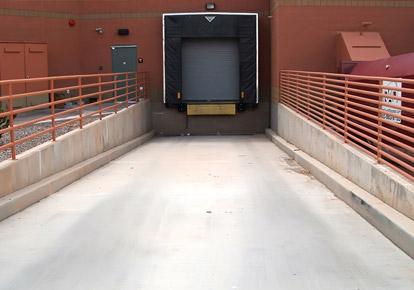Loading & Unloading Goods
When it comes to loading and unloading goods at a warehouse or other commercial facility, there are two main types of systems that are commonly used: dock high ramps and loading dock wells. While both types of systems serve the same general purpose of allowing for the efficient movement of goods in and out of a facility, there are a number of differences between the two that can impact the functionality and effectiveness of the system. In this blog, we’ll explore the differences between dock high ramps and loading dock wells to help you determine which type of system is right for your business.
What are dock high ramps and loading dock wells?
The first difference between dock high ramps and loading dock wells is the way they are constructed. Dock-high ramps are typically freestanding structures that are built next to a loading dock or warehouse door. These ramps are usually made of concrete or steel and have a slope or incline that allows vehicles to easily drive up and down. Loading dock wells, on the other hand, are built into the ground and are typically surrounded by concrete walls. These wells allow vehicles to drive into the well, which is typically at ground level, and then either drive or use a lift or forklift to load or unload goods.
Another difference between the two types of systems is the level of access they provide. Dock high ramps provide access to a loading dock or warehouse door that is at a higher elevation than the ground level. This allows for the efficient loading and unloading of goods without the need for a lift or forklift. Loading dock wells, on the other hand, provide access to a loading dock or warehouse door that is at ground level, which can make loading and unloading goods easier and more efficient in some cases.
In terms of cost, dock high ramps tend to be more expensive to construct and maintain than loading dock wells. This is due to the materials and construction required to build the ramp, as well as the ongoing maintenance needed to keep the ramp in good condition. Loading dock wells, on the other hand, tend to be less expensive to construct and maintain, as they are built into the ground and do not require as much maintenance as a ramp.
Advantages to Dock High Ramps
One advantage of dock high ramps is that they can be used to access a loading dock or warehouse door from any direction, as they are freestanding structures. Loading dock wells, on the other hand, are typically only accessible from one direction, as they are built into the ground. This can make it more difficult to access a loading dock or warehouse door from different angles, which can be a problem for some businesses.
Which one should you choose?
Finally, it’s important to consider the size and weight of the goods that will be loaded and unloaded at your facility when deciding between a dock high ramp and a loading dock well. Dock high ramps can typically handle larger and heavier loads than loading dock wells, as they are built with stronger materials and are designed to withstand greater weight. If your business handles large and heavy goods, a dock high ramp may be the better choice. If your business handles smaller and lighter goods, a loading dock well may be more suitable.
In conclusion, there are a number of differences between dock high ramps and loading dock wells that can impact the functionality and effectiveness of the system for your business. It’s important to carefully consider your business’s specific needs and goals when deciding which type of system is right for you.
List of Differences between Dock High Ramp & Loading Dock Wells
- Construction: Dock high ramps are freestanding structures built next to a loading dock or warehouse door, while loading dock wells are built into the ground and surround a loading dock or warehouse door.
- Access: Dock high ramps provide access to a loading dock or warehouse door that is at a higher elevation than ground level, while loading dock wells provide access to a loading dock or warehouse door at ground level.
- Cost: Dock high ramps tend to be more expensive to construct and maintain than loading dock wells.
- Accessibility: Dock high ramps can be accessed from any direction, while loading dock wells are typically only accessible from one direction.
- Size and weight: Dock high ramps can typically handle larger and heavier loads than loading dock wells.
- Suitability: Dock high ramps may be more suitable for businesses that handle large and heavy goods, while loading dock wells may be more suitable for businesses that handle smaller and lighter goods.


Recent Comments